Environmental Engineering Reference
In-Depth Information
figure 4.35 Cross-section of butterfly valve.
gasket-type material bonded either on the valve seat of the body or on
the edge of the disk. Because the disk of a butterfly valve stays in the
fluid path in the open position, the valve creates more turbulence (higher
resistance to flow and thus higher pressure loss) than a gate valve. On
the other hand, butterfly valves are compact. They can also be used to
control flow in either direction. This feature is useful in water treatment
plants that periodically backwash to clean filter systems.
4.13.2.6 Plug Valves
Similar to ball valves, plug valves (also known as
cock
s or
petcocks
):
•
Offer high-capacity operation (1/4 turn operation).
•
Use either a cylindrical or conical plug as the closing member.
•
Are directional.
•
Offer moderate vacuum service.
•
Allow flow throttling with interim positioning.
•
Are of a simple construction (O-ring seal).
•
Are not necessarily full on and off.
•
Are easily adapted to automatic control.
•
Can safely handle gases and liquids.
4.13.2.7 Check Valves
Check valves are usually self-acting and designed to allow the flow
of fluid in one direction only. They are commonly used at the discharge
of a pump to prevent backflow when the power is turned off. When the
direction of flow is moving in the proper direction, the valve remains
open. When the direction of flow reverses, the valve closes automatically
from the fluid pressure against it. Several types of check valves are used
in wastewater operations, including:
• Slanting disk check valves
• Cushioned swing check valves
• Rubber-lapper swing check valves























